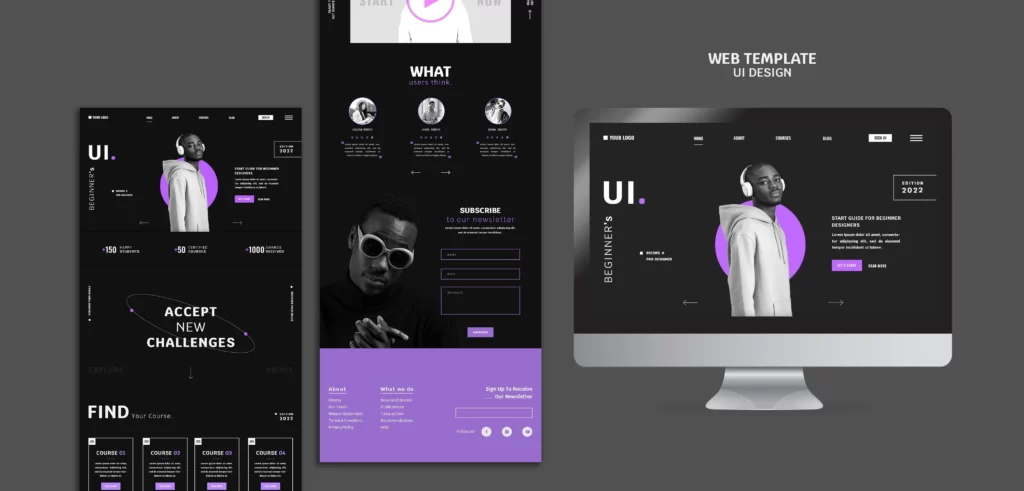
“First impressions last.” This phrase is a universal truth, especially in the realm of website design and user experience (UX). In the fiercely competitive digital world, ensuring that your website offers an unparalleled user experience is the key to standing out from the crowd. But what exactly is UX, and how can you enhance it to create successful websites? This article will delve into the depths of UX, exploring its importance, the essential elements, and how it contributes to the success of a website, backed by empirical research and scholarly insights.
Understanding UX (User Experience)
Definition of UX
At its core, user experience (UX) is about how a user interacts with, feels about, and uses a product, system, or service. It encompasses all aspects of the end-user’s interaction with a company, its services, and its products. In the context of a website, UX refers to the overall experience a visitor has while navigating and interacting with the site, including their perceptions of its efficiency, ease of use, and overall utility.
To further highlight this shift, as of 2021, mobile devices, excluding tablets, generated approximately 54.8% of global website traffic. This is a considerable increase from the previous decade, signifying the growing reliance on mobile devices for browsing the web.
Why is UX Important?
The importance of UX cannot be overstated. A good UX and a mobile friendly development approach ensures that users can easily find what they’re looking for on your site, leading to higher satisfaction levels. This satisfaction encourages repeat visits and can even influence word-of-mouth referrals. Essentially, a top-notch UX directly contributes to the success of a website by improving user engagement, increasing conversion rates, and fostering customer loyalty. Moreover, a positive UX can differentiate your website from competitors, providing a competitive advantage in the crowded digital marketplace. A study conducted in Jordan found a significant positive relationship between the quality of UX and conversion rates on e-commerce websites, highlighting the importance of UX in achieving business goals.
Unlike traditional web development methods, the mobile-first design focuses on delivering optimal user experience (UX) on the small screen. It emphasizes simplified navigation, accessible content, and bandwidth optimization for fast loading – critical features often overlooked in the conventional “desktop-first” methodology.
Essential Elements of UX
Usability
The Principles of Usability
Usability is the cornerstone of a good UX. It refers to how easy it is for users to achieve their desired tasks within your site. Some fundamental principles of usability include clarity, simplicity, consistency, and efficiency. These principles aim to create a seamless, intuitive, and satisfying user journey. For instance, a user-friendly website should have a clear and consistent navigation menu, simple and intuitive design elements, and efficient load times. The same study mentioned earlier emphasized the importance of website usability, which includes the ease of use, efficiency, and satisfaction of the website.
User Interface Design

The user interface (UI) is the point of human-computer interaction and communication on a device, software, or app. A well-designed UI should be aesthetically pleasing and easy to use, enhancing the overall UX. It includes all the buttons users click on, the text they read, the images, sliders, text entry fields, and all the rest of the items the user interacts with. This includes screen layout, transitions, interface animations, and every single micro-interaction. The quality of the user interface is a significant factor in e-service quality, which has a substantial impact on achieving a competitive advantage.
Moreover, mobile-first design improves the usability of your site, contributing to higher user engagement and, subsequently, improved SEO. Page elements such as clear, concise metadata and alt tags for images become increasingly important for mobile sites, enhancing accessibility and SEO alike.
Information Architecture
Information architecture (IA) is the structuring and organization of information on a website. A well-planned IA helps users navigate the site efficiently, finding the information they need with ease. It involves organizing information in a purposeful and meaningful way, which includes creating a logical and intuitive navigation menu, categorizing content appropriately, and implementing effective search functionality.
Moreover, mobile-first design improves the usability of your site, contributing to higher user engagement and, subsequently, improved SEO. Page elements such as clear, concise metadata and alt tags for images become increasingly important for mobile sites, enhancing accessibility and SEO alike.
Interaction Design
Interaction design refers to the creation of engaging interfaces with well-thought-out behaviors and actions. Good interaction design ensures that users can interact with your site in intuitive and meaningful ways. It involves understanding how users prefer to interact with your site and designing the site to meet those expectations. This could include elements like how the site responds when users hover over a button, how a menu unfolds, or how users canswipe through a photo gallery.
How UX Enhances Website Success
Increased User Engagement
When users enjoy a positive experience on your website, they are more likely to engage with your content, spend more time on your site, and eventually convert. This engagement can take many forms, such as sharing your content on social media, leaving comments, or participating in community discussions. High user engagement is often a sign of a strong UX. Research has shown that the quality of UX has a significant positive impact on user satisfaction and loyalty, which can lead to increased user engagement.

Improved Conversion Rates
With an enhanced UX, users can easily find what they need and follow through with actions, such as making a purchase, signing up for a newsletter, or filling out a contact form. This ease of use can significantly improve your conversion rates. A well-designed call-to-action, for instance, that is easy to find and understand, can lead to higher conversion rates. Empirical evidence supports this, with studies showing a significant positive relationship between the quality of UX and conversion rates on e-commerce websites.
Boosted Customer Retention
A great UX can turn casual visitors into loyal customers. If users find value in your website and enjoy the experience, they are more likely to return and recommend your site to others. This is because a positive UX can foster trust and satisfaction among users, making them more likely to stick around and become repeat customers. Studies have shown that the quality of UX has a significant positive impact on user loyalty, further emphasizing the importance of UX in customer retention.
Best Practices for Enhancing UX
Incorporating User Feedback
One of the most effective ways to enhance UX is to listen to your users. Gathering feedback, understanding their needs and pain points, and incorporating this insight into your design process is crucial. This could involve conducting user surveys, analyzing user behavior through analytics, or even observing users interact with your site in usability tests.
Utilizing UX Design Tools
There are various tools available that can help you prototype, design, and test your UX strategies. Some popular ones include Sketch, InVision, and Adobe XD. These tools can help you visualize your ideas, create interactive prototypes, and test them before implementation. They can also facilitate collaboration among team members, making it easier to gather feedback and make improvements.
Consistent Testing and Optimization
Continuous testing and optimization is crucial for improving UX. Regularly test your website’s usability and make necessary adjustments based on the results. This could involve A/B testing different design elements, conducting usability tests, or using heat maps to understand how users interact with your site. Remember, UX design is not a one-time process but a continuous one that requires regular evaluation and refinement. Research emphasizes the importance of continuous improvement in e-service quality by comparing services with the best in the market and exploring user needs and requirements.
Conclusion
In conclusion, UX is not just a buzzword; it’s a crucial ingredient for successful websites. By focusing on usability, UI design, information architecture, and interaction design, you can enhance the UX and ultimately boost engagement, conversion rates, and customer retention. Remember, the key is to keep your users at the heart of your design process. After all, a website is for the user, and a great user experience leads to a successful website. Empirical research and scholarly insights underscore the importance of UX in achieving business goals and competitive advantage.
FAQs
What is UX?
Why is UX important in website design?
What are the essential elements of UX?
How do I balance visual appeal and functionality in a mobile-first design?
What are some best practices for enhancing UX?

Written By- Lucas Samuel
PROJECT MANAGER
Digital Strategist | SEO Analyst | Website Analytics Expert
10+years experience in digital marketing Industry



